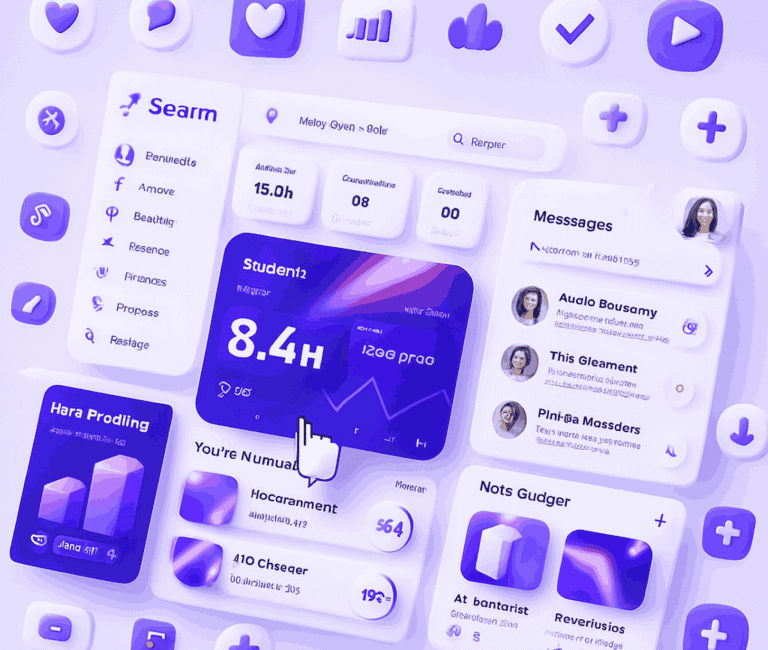
Super apps are changing how we interact with digital services — and fast. These all-in-one platforms are growing at an impressive annual rate of 27.8%, and nearly one-third of users already rely on them to handle everything from messaging to shopping and payments.
By merging multiple services into one ecosystem, super apps like WeChat and Alipay set the trend in Asia — and now, Western markets are beginning to show serious interest. For businesses, these platforms offer a way to build richer, more connected digital experiences. While development costs range anywhere between $65,000 and $300,000, the potential payoff makes the investment worth considering.
Let’s break down what goes into building a super app that doesn’t just pack in features — but delivers a user experience that feels effortless.
Start with the User: Designing for Real People
“You can’t design good experiences without understanding people.”
— Dieter Rams, German Industrial Designer
The key to creating a successful super app lies in deeply understanding your users — how they behave, what they need, and what they expect.
Research shows that users rely on super apps to access a wide mix of services — messaging, e-commerce, ride-hailing, payments, and more — all within a single app. These platforms essentially serve as mobile-first ecosystems that bridge both physical and digital worlds.
Analyzing User Behavior for Better Design
Understanding how people interact with your platform is non-negotiable. For example, Under Armour discovered through data that its race training plans weren’t engaging users effectively. By studying behavior patterns, they revised their offerings — adding a broader range of goals from simple jogging to cardio-focused plans.
Super apps give product teams access to similar behavioral insights. By analyzing real-time data and performance metrics, companies can refine their app’s experience, drive smarter updates, and release features that users truly want.
Recognizing Pain Points in the Super App Model
While convenient, super apps also come with their challenges:
- Overloaded interfaces can lead to decision fatigue and user drop-off.
- Security risks grow with the amount of sensitive payment and personal data stored.
- Older users often resist adopting new or complex features.
Addressing these pain points early in the design process is critical to long-term success.
Choosing the Right Features: A Strategic Approach
To prioritize effectively, product teams often use methods like:
- RICE (Reach, Impact, Confidence, Effort) — to assess and rank feature ideas
- The Kano Model — to group features into:
- Must-Haves – core functionalities users expect
- Satisfiers – features that work well and enhance usability
- Delighters – unexpected bonuses that create “wow” moments
- Indifferent – extras that don’t add much value
By choosing features that align with both user needs and business goals, you build smarter and faster — with fewer wasted resources.
Core Building Blocks of a Super App
Behind every great super app is a well-structured architecture that connects services without creating chaos. Most start with a core function — like messaging or ride-hailing — and then expand into other verticals once user trust is established.
The Four-Layered Structure
- Client Layer – Manages user interactions and visual interfaces
- Gateway Layer – Processes incoming requests securely
- Service Layer – Executes core app logic and functionality
- Data Layer – Stores, retrieves, and manages all data
These layers are supported by scalable, cloud-native platforms that adapt to traffic spikes and enable smooth development pipelines.
Key technologies include:
- API Gateways for secure routing and authentication
- Service-Oriented Architecture (SOA) for modular, reusable components
- Cloud Infrastructure for performance and scalability
Payments: The Heart of Super App Engagement
Integrated payments make or break a super app. They power everything from ride bookings to cross-border transfers, QR payments, and bill splitting.
A well-designed payment system allows users to enter their details once and use them across all services — making transactions quick and seamless.
More importantly, payment systems collect data that can be used to personalize financial experiences, suggest savings tips, and build loyalty features that increase app usage.
Delivering a Seamless User Experience
“A great interface is one that works exactly how the user expects it to.”
— Joel Spolsky, CEO & Co-Founder, Stack Overflow
Building a feature-rich app is only part of the job. Ensuring that the app feels intuitive and enjoyable to use is just as critical.
Smart Onboarding for Lasting Engagement
First impressions matter. Super apps often use progressive onboarding, where users are gradually introduced to features instead of being overwhelmed with lengthy tutorials.
Common strategies include:
- Function-oriented flows — showing key features first
- Benefit-driven introductions — emphasizing value early
- Interactive walkthroughs — using gamified elements for engagement
Smooth Transitions Between Services
Switching between services should feel natural — not like jumping between unrelated apps.
Design elements that support this include:
- Unified branding across all modules
- Clear menu structures for fast navigation
- Quick-search features optimized for mobile use
Personalization: The Secret to Retention
The best super apps feel like they were built just for you. By analyzing user data and behavior, these platforms can suggest content, services, or deals at just the right time.
Some personalization features include:
- Custom dashboards with favorite shortcuts
- AI-based recommendations
- Spending breakdowns and financial advice
- Biometric login options for faster, more secure access
For example, if a user regularly books rides on Monday mornings, the app can proactively suggest rides with optimized routes and pricing.
Case Studies: Super Apps Done Right
Let’s look at two platforms that mastered both design and strategy in their super app journeys.
WeChat: Leading Through Innovation
Initially launched as a messaging app, WeChat evolved into China’s ultimate super app. It created internal competition with sibling app QQ to fuel faster innovation and product growth.
Instead of focusing on ad revenue, WeChat prioritized user experience — limiting ads in users’ feeds to just two per day. That user-first approach paid off, with over 1.3 billion monthly active users.
Their breakthrough? Mini-programs — lightweight apps within WeChat that allowed small and large businesses to engage users directly. These mini-apps generated over 2.7 trillion RMB in transactions across 3.5 million programs.
Grab: Built for the Local Market
In Southeast Asia, Grab took the super app model and tailored it to meet regional needs. Operating in over 428 cities across 8 countries, it dominates ride-hailing and food delivery in the region.
Grab’s success came from solving real-world problems:
- Trip monitoring to detect route changes
- Crash detection with built-in emergency alerts
- AI-based delivery dispatching based on location and traffic
These features built trust in fast-growing urban areas. As a result, Grab users engaging with multiple services grew 5x in just two years — proving that integration boosts retention and spending.
What’s Next for Super Apps?
Super apps are reshaping digital ecosystems across the globe. Their continued growth shows that users want fewer apps that do more — but only if those apps are intuitive, secure, and personalized.
The winning formula includes:
- Scalable infrastructure
- Streamlined payment systems
- Thoughtful, user-centric design
As more brands explore super app development, success will come to those who master the balance between robust functionality and flawless UX.
Final Thoughts
Super apps aren’t just tech trends — they’re the future of digital interaction. But building one takes more than stacking features together.
It demands a clear vision, deep user understanding, and collaboration with developers who understand both the technical and experiential sides of the process.
When done right, a super app becomes more than just a platform — it becomes a part of people’s everyday lives.


